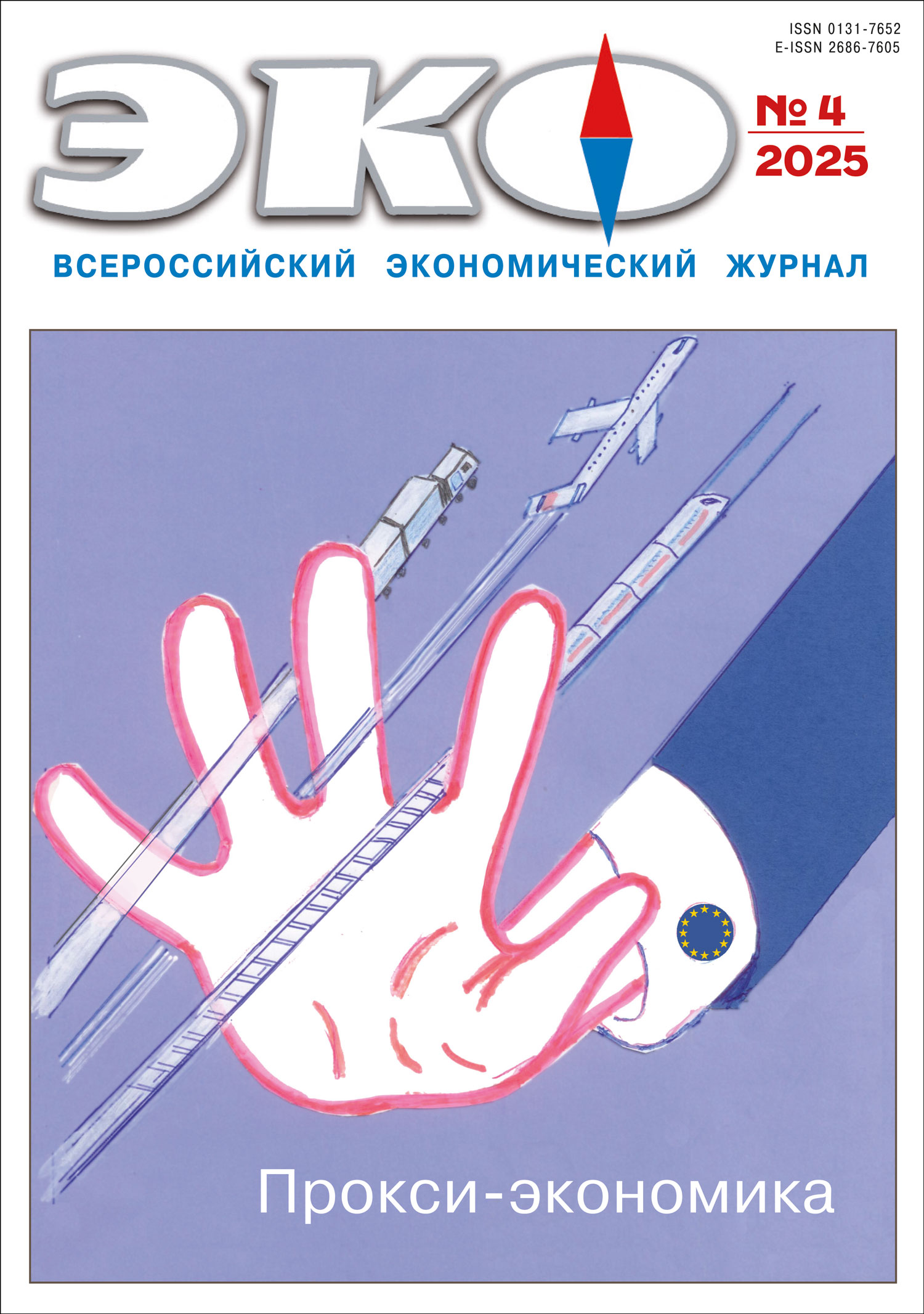DEBATES
Published 2025-07-24
Keywords
- international monetary system; Bretton Woods system; International Monetary Fund; conversion of dollars into gold
How to Cite
1.
Gluschenko К. On the Mythology of Economic History. ECO [Internet]. 2025 Jul. 24 [cited 2025 Nov. 10];55(4):252-66. Available from: https://ecotrends.ru/index.php/eco/article/view/4892
Abstract
The paper examines several common myths in the history of the international monetary system. Neither the Paris Conference of 1867 nor the Genoa Conference of 1922 resulted in any international agreements that allegedly marked the beginning of the “Paris” and “Genoa” monetary systems. Speculation about the essence of the Bretton Woods monetary system and the reasons for the USSR’s refusal to ratify the Bretton Woods agreements is discussed. The legend of a French ship sent to the US in 1965 or 1971 for gold received by France in exchange for dollars is debunked. The 1974 agreement between the US and Saudi Arabia is analyzed, according to which Saudi Arabia allegedly agreed to sell oil only for dollars.References
- Атлас З. Мировая валютная проблема // Большевик. 1944. № 15. С. 29–41.
- Беленчук С.И. СССР после Победы: отказ от Бреттон-Вудса и начало формирования бездолларовой экономической зоны // Вестник РГГУ: Серия «Экономика. Управление. Право». 2020. № 2. С. 105–114. DOI: 10.28995/2073–6304–2020–2–105–114
- Берсенёв В.Л., Горст А.П. О возможностях ретроальтернативистики применительно к экономическому анализу // ЭКО. 2025. № 1. С. 232–243. DOI: 10.30680/ECO131–7652–2025–1–232–243
- Бугров А.В. Международные монетарные конференции второй половины XIX века (взгляд из России) // Деньги и кредит. 2014. № 7. С. 55–62.
- Катасонов Ю.В. Генуэзская конференция в контексте мировой и российской истории. М.: ИД «Кислород», 2015.
- Международные валютно-кредитные и финансовые отношения / Под ред. А.М. Алексеева. М.: Международные отношения, 1984.
- Международные валютно-кредитные и финансовые отношения / Под ред. Л.Н. Красавиной. 3-е изд. М.: Финансы и статистика, 2005.
- Международные валютные и кредитные отношения капиталистических стран / Под ред. Л.Н. Красавиной. М.: Финансы и статистика, 1986.
- Минкова К.В. «Советская делегация считает целесообразным вступление Советского Союза в состав членов Фонда»: СССР и Международный валютный фонд в 1943–1946 гг. // Вестник РУДН. Серия: Международные отношения. 2017. Т. 17. № 1. С. 34–47. DOI: 10.22363/2313–0660–2017–17–1–34–47
- Нешатаева Т.Н. Мировой банк и Международный валютный фонд: правовая идея и реальность // Московский журнал международного права. 1993. № 2. С. 82–100. DOI: 10.24833/0869–0049–1993–2–82–100
- Привалов К. Все золото мира // Итоги. 2008. № 11. С. 32–36.
- Сироткин В.Г., Алексеев Д.С. СССР и создание Бреттон-Вудской системы 1941–1945 гг.: политика и дипломатия // Новая и новейшая история: Межвуз. сб. науч. тр. Саратов, 2004. № 21. С. 72–89.
- Трахтенберг И. Проекты международных валютных соглашений // Мировое хозяйство и мировая политика. 1944. № 1–2. С. 25–40.
- Хватов Ю.Ю. Парижская денежная (валютная) конференция 1867 г.: мифы и реальность // Академiчний огляд. 2011. № 2. С. 65–72.
- Эйхенгрин Б. Глобальные дисбалансы и уроки Бреттон-Вудса. М.: Изд-во Института Гайдара, 2017.
- Bordo, M.D., Simard, D., White, E.N. (1995). France and the Bretton Woods International Monetary System 1960 to 1968. In: International Monetary Systems in Historical Perspective. London: Palgrave Macmillan. Pp. 153–180. DOI: 10.1007/978–1–349–24220–7_8
- Eichengreen, B., Chiţu, L., Mehl, A. (2016). Stability or upheaval? The currency composition of international reserves in the long run. IMF Economic Review. Vol. 64. No. 2. Pp. 354–380. DOI: 10.1057/imfer.2015.19
- Einaudi, L.L. (2000). From the franc to the ‘Europe’: the attempted transformation of the Latin Monetary Union into a European Monetary Union, 1865–1873. The Economic History Review. Vol. 53. No. 2. Рp. 284–308. DOI: 10.1111/1468–0289.00161
- Giscard d’Estaing, V., Walrafen, T., Le Boucher, É. (1994). Le témoignage de Valéry Giscard D’Estaing. In: Bretton Woods: mélanges pour un cinquantenaire. Paris: Le Monde éditions. Pp. 319–322.
- Gold, J. (1974). Membership and Nonmembership in the International Monetary Fund. Washington, D.C.: IMF. DOI: 10.5089/9781455215935.071
- Graetz, M.J., Briffault, O. (2019). A “barbarous relic”: The French, gold, and the demise of Bretton Woods. In: Bretton Woods Agreements: Together with Scholarly Commentaries and Essential Historical Documents. New Haven, CT: Yale University Press. Pp. 121–142. DOI: 10.2307/j.ctvk8vz01.9
- Hexner, E. (1946). The Soviet Union and the International Monetary Fund. The American Journal of International Law. Vol. 40. No. 3. Pp. 637–640. DOI: 10.1017/S0002930000158415
- Irwin, D.A. (2013). The Nixon shock after forty years: the import surcharge revisited. World Trade Review. Vol. 12. No. 1. Pp. 29–56. DOI: 10.1017/S1474745612000444
- Lindert, P.H. (1969). Key currencies and gold: 1900–1913. Princeton Studies in International Finance. No. 24. Princeton, N.J.: Princeton University.
- Mandeng, O.J. (2024). Bretton Woods – Why the dollar? The Bretton Woods Committee. April 4. https://www.brettonwoods.org/article/bretton-woods-why-the-dollar
- Mikesell, R.F. (1951). Negotiating at Bretton Woods, 1944. In: Negotiating with the Russians. Boston: World Peace Foundation. Pp. 99–116.
- Mroczkowski, P. (1988). History of Poland’s Relations with the IMF and the World Bank. In: Creditworthiness and Reform in Poland: Western and Polish Perspectives. Bloomington: Indiana University Press. Pp. 253–258.
- Triffin, R. (1968). Our International Monetary System. N.Y.: Random House.
- Volcker, P.A., Gyohten, T. (1992), Changing Fortunes: The World’s Money and the Threat to American Leadership. New York: Times Books.

